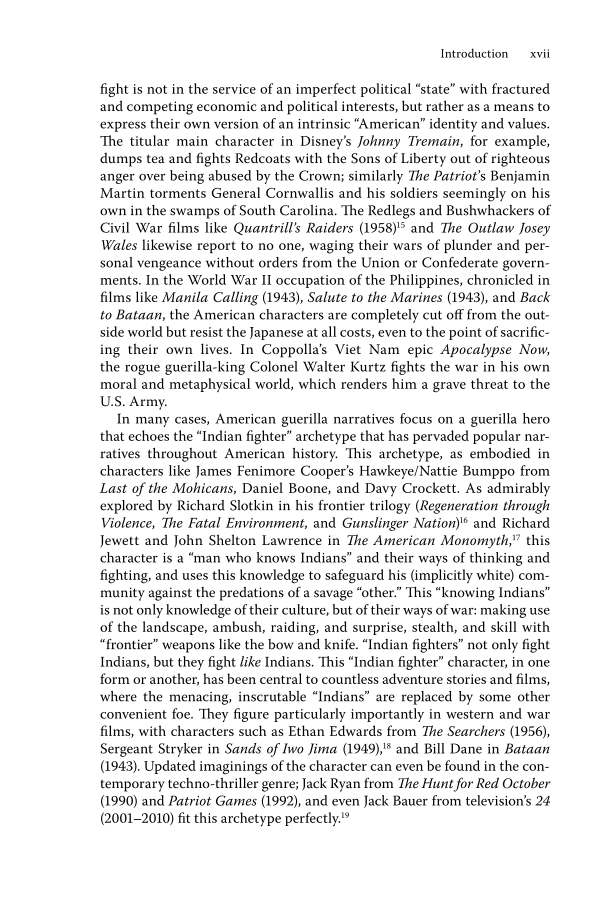Introduction xvii fi ght is not in the service of an imperfect political “state” with fractured and competing economic and political interests, but rather as a means to express their own version of an intrinsic “American” identity and values. Th e titular main character in Disney’s Johnny Tremain , for example, dumps tea and fi ghts Redcoats with the Sons of Liberty out of righteous anger over being abused by the Crown similarly Th e Patriot ’s Benjamin Martin torments General Cornwallis and his soldiers seemingly on his own in the swamps of South Carolina. Th e Redlegs and Bushwhackers of Civil War fi lms like Quantrill’s Raiders (1958) 15 and Th e Outlaw Josey Wales likewise report to no one, waging their wars of plunder and per- sonal vengeance without orders from the Union or Confederate govern- ments. In the World War II occupation of the Philippines, chronicled in fi lms like Manila Calling (1943), Salute to the Marines (1943), and Back to Bataan , the American characters are completely cut off from the out- side world but resist the Japanese at all costs, even to the point of sacrifi c- ing their own lives. In Coppolla’s Viet Nam epic Apocalypse Now , the rogue guerilla-king Colonel Walter Kurtz fi ghts the war in his own moral and metaphysical world, which renders him a grave threat to the U.S. Army. In many cases, American guerilla narratives focus on a guerilla hero that echoes the “Indian fi ghter” archetype that has pervaded popular nar- ratives throughout American history. Th is archetype, as embodied in characters like James Fenimore Cooper’s Hawkeye/Nattie Bumppo from Last of the Mohicans , Daniel Boone, and Davy Crockett. As admirably explored by Richard Slotkin in his frontier trilogy ( Regeneration through Violence , Th e Fatal Environment , and Gunslinger Nation ) 16 and Richard Jewett and John Shelton Lawrence in Th e American Monomyth , 17 this character is a “man who knows Indians” and their ways of thinking and fi ghting, and uses this knowledge to safeguard his (implicitly white) com- munity against the predations of a savage “other.” Th is “knowing Indians” is not only knowledge of their culture, but of their ways of war: making use of the landscape, ambush, raiding, and surprise, stealth, and skill with “frontier” weapons like the bow and knife. “Indian fi ghters” not only fi ght Indians, but they fi ght like Indians. Th is “Indian fi ghter” character, in one form or another, has been central to countless adventure stories and fi lms, where the menacing, inscrutable “Indians” are replaced by some other convenient foe. Th ey fi gure particularly importantly in western and war fi lms, with characters such as Ethan Edwards from Th e Searchers (1956), Sergeant Stryker in Sands of Iwo Jima (1949), 18 and Bill Dane in Bataan (1943). Updated imaginings of the character can even be found in the con- temporary techno-thriller genre Jack Ryan from Th e Hunt for Red October (1990) and Patriot Games (1992), and even Jack Bauer from television’s 24 (2001–2010) fi t this archetype perfectly. 19
Document Details My Account Print multiple pages
Print
You have printed 0 times in the last 24 hours.
Your print count will reset on at .
You may print 0 more time(s) before then.
You may print a maximum of 0 pages at a time.


















































































































































































































































